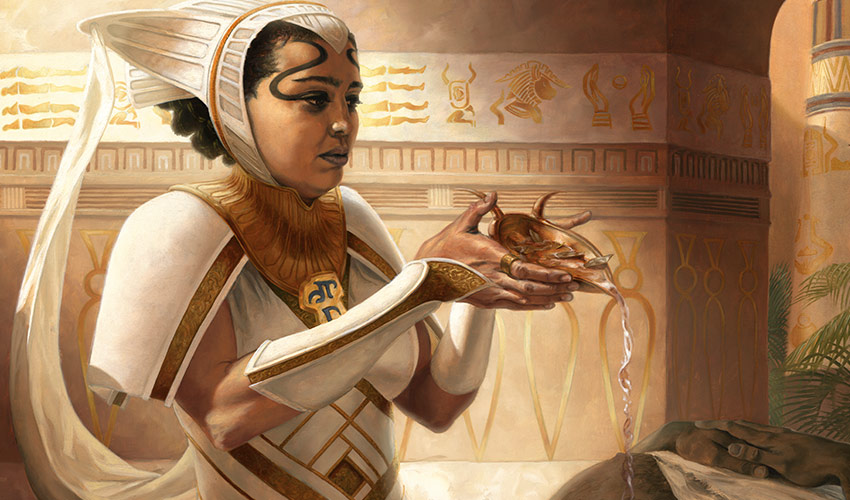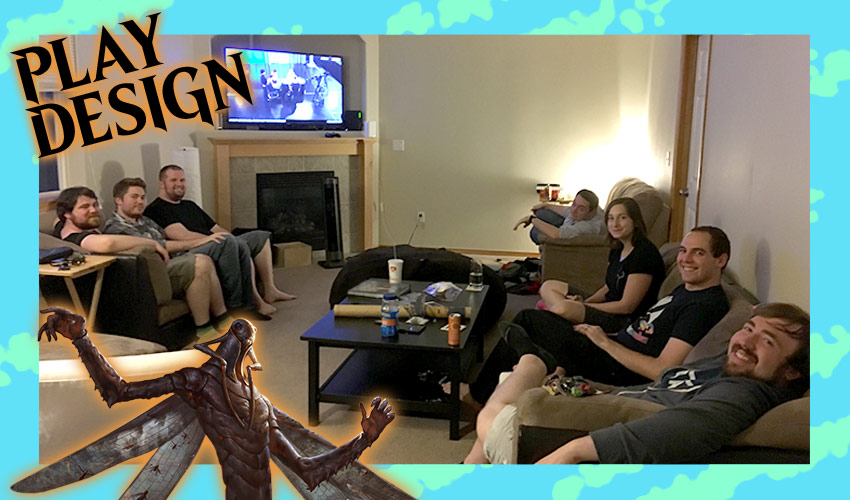Philosophy of Combo
Welcome back to Play Design. Today we're going to be talking about combo decks and R&D's guidelines and philosophy behind them. The first thing I want to point out is that we don't have hard and fast rules for combo decks, just guidelines that we follow to meet our goal to create a fun environment.
What Is Combo?
A combo refers to cards that interact with each other in a way that's significantly stronger than the sum of their parts. For example, a single Pestermite by itself isn't very impactful. A single Splinter Twin by itself doesn't do anything. However, these two cards in combination create an infinite number of creatures. That interaction is significantly stronger than the two cards individually.
What Is Synergy?
Synergy refers to cards that work well together and enhance the value of each other. Decks that are high in synergy are sometimes combo decks, but not always. For example, Goblin Tribal is a synergistic deck, but not a combo deck.
A combo deck is a type of synergy deck. You are trying to assemble a group of cards that gives you a powerful effect all at once. Usually this effect is your win condition. We think it's healthy to have both combo and synergy in Magic because it allows for exploration and makes deck building fun. However, some combos are not healthy in Magic and some are even oppressive.
Here are some of the guidelines we follow for making combo fun and healthy.
Speed
It's not healthy for combo decks to be faster than the fastest aggro deck in a format. It forces aggro into a pure race they can't win, as they have zero interaction. When there is no interaction, combo versus aggro is not an interesting matchup because both decks are essentially goldfishing; the matchup is lopsided and not fun. When combo is faster than aggro, it removes the role of aggro in the metagame.
An example of this is Zoo versus Storm in Legacy. There was a time when Zoo was one of the fastest aggressive decks in the format, but Storm combo was just a turn faster. Zoo had very few ways to interact with Storm, and soon Zoo became nonexistent in the metagame. In current Legacy, we don't really see much pure aggro because it can't win faster than the combo decks.
Interactivity
It's healthy when combos can be interacted with. A type of combo we try to avoid is one that can win in one turn from an empty board, such as storm. Storm combo can win out of nowhere. It doesn't use permanents but rather uses spells from hand. Interaction spells like counters don't even work against it; you need a specific type of counter like Stifle or Flusterstorm.
There are lots of combos that are fun and powerful that can also be interacted with. Usually these combos require multiple pieces and you must leave them vulnerable for a period of time. A combo deck that has been gaining popularity in Modern recently plays Devoted Druid and Vizier of Remedies. This combo allows for infinite mana, and while it only requires two cards, it's somewhat difficult to pull off. First, Devoted Druid must stay in play for a turn. Second, both of these creatures must survive removal. Third, you can't just win with these two cards; you need something to do with the infinite mana. So while this is a powerful effect that you can pull off as early as turn three, there are a lot of interaction points available to stop it.
Pyromancer Ascension is another combo card that we consider healthy because there are multiple ways to interact with it. While it only uses one card and sets up a one-turn kill, it must be built up over time and can be disrupted using enchantment removal or graveyard removal.
Healthy combos can be disrupted using cards that people commonly play, or require more than a turn, or give the opponent a window to do something.

Consistency
The most consistent combos require the fewest cards and have the most redundant cards. When combos are too consistent, they can create an unhealthy environment. Two-card combos require you to draw both of those cards in a game, but sometimes the combo pieces have redundancy, which leads to these decks becoming too consistent. For example, in Splinter Twin combo decks, Deceiver Exarch and Pestermite play the same role, as well as Splinter Twin and Kiki-Jiki, Mirror Breaker. Having a playset of each of these in your deck means that you are essentially playing eight copies of each of your combo pieces.
When combos exist, we have to be extra careful about hand manipulation and tutoring. Too many of these cards can make many combo decks too consistent all at once. Ponder, Preordain, Green Sun's Zenith, Vampiric Tutor, and other cards like this really limit design space in their respective formats. When we don't have a high tutor/hand-manipulation count, it allows us to take more risks and print cooler combo pieces because there is a limit on how consistent a combo deck will be. When you can easily find the cards you need, the combo decks win rate becomes much higher and will push a lot of other decks out of the metagame.
Deck-Building Cost
One thing to consider when building combo decks is the cost to actually put the combo into your deck. Do the cards do anything on their own? What does your deck do if the combo doesn't get assembled?
Take Aetherworks Marvel (pre–Aether Revolt) for example. This version of Marvel did not perform as well as Marvel decks did after Aether Revolt was released. It played cards that did not do a whole lot on their own, such as Woodweaver's Puzzleknot or a ten-mana Eldrazi. Marvel decks became much more consistent once Aether Revolt hit due to the stronger energy pieces like Rogue Refiner allowing the deck to have a "plan B." If you didn't draw your combo, you could still easily win with cards like Whirler Virtuoso and Rogue Refiner. This meant the opponent had to attack the deck from different angles. If they dealt with the Marvel or the Ulamog, the Ceaseless Hunger, they may not have had the resources to deal with the creatures. The opponent just needed too many different answers, and that kind of combo deck is not healthy for Standard.
Given these guidelines, here are some examples of combos that are fun and healthy for Standard:
Zulaport Cutthroat, Brood Monitor, and Eldrazi Displacer—This is a three-card combo across three colors. All of the combo pieces are creatures, making the combo easy to interact with.
New Perspectives Combo—While this can win from an empty board, the deck doesn't do anything until turn six and can be disrupted with counters or enchantment removal.
Sram, Senior Edificer; Paradoxical Outcome; and Aetherflux Reservoir—There are many ways to interact with these pieces, and you need Sram in play to go off. The deck lacks consistency and often can't win if it doesn't draw Paradoxical Outcome.
We like combo existing in Standard, but we have to be careful with how strong and consistent the combos are. It's important for different archetypes to be playable in Standard, and the existence of strong combo can push many strategies out.
Play Design Story of the Week
Part of what we do in Play Design is keep up with real-world Standard. This allows us to react to player feedback and solve potential problems with future sets. Pro Tour Hour of Devastation was last weekend, and many of us met at Play Design team member Andrew Veen's House for a Pro Tour viewing "party." Being in the same room together allowed us talk about decks and plays as they were happening on coverage. It was exciting to see the all the cool plays together as a group and discuss what cards players could draw to get out of certain situations or what plays we would have made differently. Viewing parties are my favorite way to watch coverage. Friends and community are part of what makes Magic one of the greatest games in the world.

Until next time,
Melissa DeTora
@MelissaDeTora
